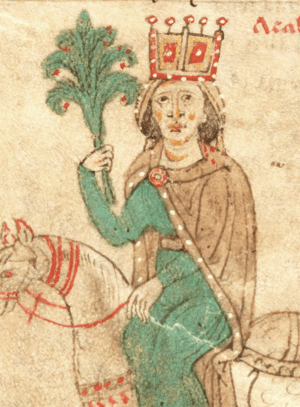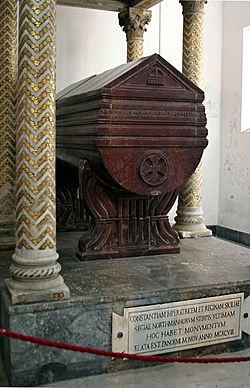Constance, Queen of Sicily facts for kids
Quick facts for kids Constance I |
|
|---|---|

Constance of Sicily (from Liber ad Honorem Augusti by Peter of Eboli, 1196)
|
|
| Queen of Sicily | |
| Reign | 1194 – 27 November 1198 |
| Predecessor | William III |
| Successor | Frederick II |
| Holy Roman Empress Queen consort of the Romans |
|
| Tenure | 1191–1197 |
| Born | 2 November 1154 Palermo, Kingdom of Sicily |
| Died | 27 November 1198 (aged 44) Palermo, Kingdom of Sicily |
| Spouse | Henry VI, Holy Roman Emperor |
| Issue | Frederick II, Holy Roman Emperor |
| House | Hauteville |
| Father | Roger II of Sicily |
| Mother | Beatrice of Rethel |
Constance I (born November 2, 1154 – died November 27, 1198) was a powerful queen. She was the Queen of Sicily from 1194 to 1198. She ruled first with her husband, Henry VI, Holy Roman Emperor, and then with her young son, Frederick II, Holy Roman Emperor. Constance was the only direct heir to the Norman kings of Sicily.
She also became the Holy Roman Empress when she married Henry VI. Constance was unusual because she did not marry until she was 30 years old. This was partly due to an old prophecy. After becoming empress, she fought a war against her nephew, Tancred of Sicily, for the Sicilian throne. During this fight, she was even captured, which was very rare for an empress.
Constance gave birth to her only child, Frederick, when she was 40. This was important because it continued the royal families of both the Holy Roman Empire and the Kingdom of Sicily. After her husband died, she gave up the Holy Roman Empire's throne for her son. She wanted him to be King of Sicily only. She died a year later and asked Pope Innocent III to protect her young son.
Contents
Early Life and Marriage
Constance was the daughter of Roger II of Sicily, a powerful king. Her mother was Beatrice of Rethel. Constance was born after her father had died.
It was very unusual for a princess not to be engaged until she was thirty. Stories later claimed she had been a nun. Some believed a prophecy said her marriage would "destroy Sicily." This led to ideas that she was kept in a convent to remain unmarried. However, historians now think she was kept unmarried for political reasons. She was a valuable heir to the throne.
In 1172, Constance became the only heir to the Sicilian crown. This happened because her nephew, King William II of Sicily, had no children. Even though she was the heir, she stayed in her convent. Her marriage was not considered until she was 30.
Her engagement to Henry, who was King of the Romans, was announced in 1184. This marriage was supported by Pope Lucius III. In 1185, Constance traveled to Milan for her wedding. She had a grand procession of princes and nobles with her.
Henry and Constance were married on January 27, 1186, in Milan. This marriage was meant to create an alliance between Germany and Sicily. Before she left Sicily, King William II made his nobles promise to accept Constance as his successor.
Claiming the Throne of Sicily
The nobles of Sicily did not want a German king. So, after King William II died in 1189, Tancred took the throne. Tancred was not a legitimate heir, but he had strong support. However, many important people, like Archbishop Walter of the Mill, supported Constance.
Joan of England, William's widow, also believed Constance was the rightful queen. She supported the Germans. Because of this, Tancred put Queen Joan under house arrest.
First Attempt to Take Sicily
Constance and Henry could not immediately claim Sicily because Henry's father was on a crusade. After his father died in 1190, Henry and Constance were crowned emperor and empress. In 1191, Constance joined her husband and a large army to take the Sicilian throne from Tancred.
Many towns in northern Sicily welcomed Henry's army. Salerno, an important city, invited Constance to stay in her father's old palace. However, many citizens were still loyal to Tancred.
At Naples, Henry's army faced strong resistance. The siege lasted through the summer. Many soldiers got sick with malaria. Henry himself became ill. Because of this, the imperial army had to leave Sicily. Constance stayed in Salerno with a small group of soldiers. This was a sign that Henry would return soon.
Constance is Captured
After Henry left, the towns that had supported him quickly switched back to Tancred. The people of Salerno saw a chance to gain favor with Tancred. They attacked Constance, who was left with only a small guard. Constance tried to calm them, but they wanted to capture her for Tancred.
Constance eventually agreed to surrender. She was arrested by some nobles and taken to Messina by Admiral Margaritus of Brindisi. She was dressed in her empress's clothes, covered in jewels. She looked very grand. Constance became a valuable prisoner for Tancred. When she met Tancred, she bravely told him she was only taking back what was hers.
Constance was taken to Palermo. Queen Sibylla, Tancred's wife, supervised her. Sibylla suggested that Tancred kill Constance, but he refused. He worried it would make him unpopular. Instead, Constance was imprisoned in Castel dell'Ovo in Naples. This castle was surrounded by water and was easy to guard.
Tancred treated Constance politely during her captivity. However, she was watched very carefully. Sibylla did not like how much respect Tancred showed Constance.
Henry VI refused to make peace with Tancred while his wife was captured. He complained to Pope Celestine III about her capture. The Pope threatened to excommunicate Tancred if he did not release Constance. The Pope hoped that by helping Constance, Henry would be more friendly towards the Church.
Constance was released in 1192. She was given gifts and traveled with her attendants. Before she reached Rome, she met imperial soldiers. They helped her travel safely across the Alps. Within two weeks, Henry and Constance were reunited.
Second Attempt to Take Sicily
Henry was already planning another invasion of Sicily when Tancred died in February 1194. Later that year, Henry moved south. He destroyed Salerno as revenge for Constance's capture. He entered Palermo without a fight. He removed Tancred's young son, William III of Sicily, from the throne. Henry then crowned himself King of Sicily.
Queen of Sicily
While Henry marched south with his army, Constance, who was pregnant, followed more slowly. On December 26, the day after Henry was crowned in Palermo, she gave birth to a son. His name was Frederick-Roger, who would become Frederick II, Holy Roman Emperor. He was born in the town of Iesi.
There is a story that Constance, at 40 years old, gave birth publicly in the town square. This story came about later to stop rumors that Frederick was not her son.
When Henry returned to Germany in 1195, Constance ruled Sicily. She issued official documents in her own name. She was crowned queen on April 2 in Bari.
In 1196, Henry VI had Richard, Count of Acerra, Sibylla's brother, executed. This was revenge for Constance's capture.
Henry's rule in Sicily was very harsh. This caused revolts, especially in southern Sicily. Henry tried to calm the Sicilians by making Constance regent. But she was seen as his tool and could not stop him from putting Germans in charge. Henry crushed a rebellion led by Jordan Lupin. Henry had Jordan executed in front of Constance. Constance felt pity for her people. She joined the revolts against her husband. She even besieged him in a castle, forcing him to make a treaty.
Frederick II's Crowning and Constance's Death

In 1197, Henry returned to Sicily. There was a plot to murder him. Some believed Constance and the Pope might have been involved. Henry died unexpectedly in September. Some people said Constance poisoned him.
The next year, Constance had her three-year-old son, Frederick, crowned King of Sicily. She became his regent. She broke the ties her husband had made between Sicily and the Holy Roman Empire. She chose local advisors instead of German ones. She did not claim the German kingship for her son. She wanted him to be only King of Sicily.
Constance's health became poor. She made friendly agreements with the new pope, Pope Innocent III. She placed Frederick under the Pope's protection. The Pope made her give up some royal rights over the church. She died unexpectedly in November 1198.
In her will, she set up a group of people to rule Sicily for her son. She also made Pope Innocent III his guardian. This showed everyone that Frederick's inheritance was safe. She also told her people to be loyal to the Pope.
Constance was buried in the Cathedral of Palermo, next to her father. Her death led to a time of trouble in Sicily. This lasted until 1208, when Frederick became an adult.
In the famous poem Divine Comedy, Dante places Constance in Paradise. He believed the story that Constance had been a nun.
Constance had planned for her son to marry a princess from Aragon. This marriage happened in 1209.
Images for kids
-
Constance's tomb, in the Cathedral of Palermo.
See also
 In Spanish: Constanza I de Sicilia para niños
In Spanish: Constanza I de Sicilia para niños



